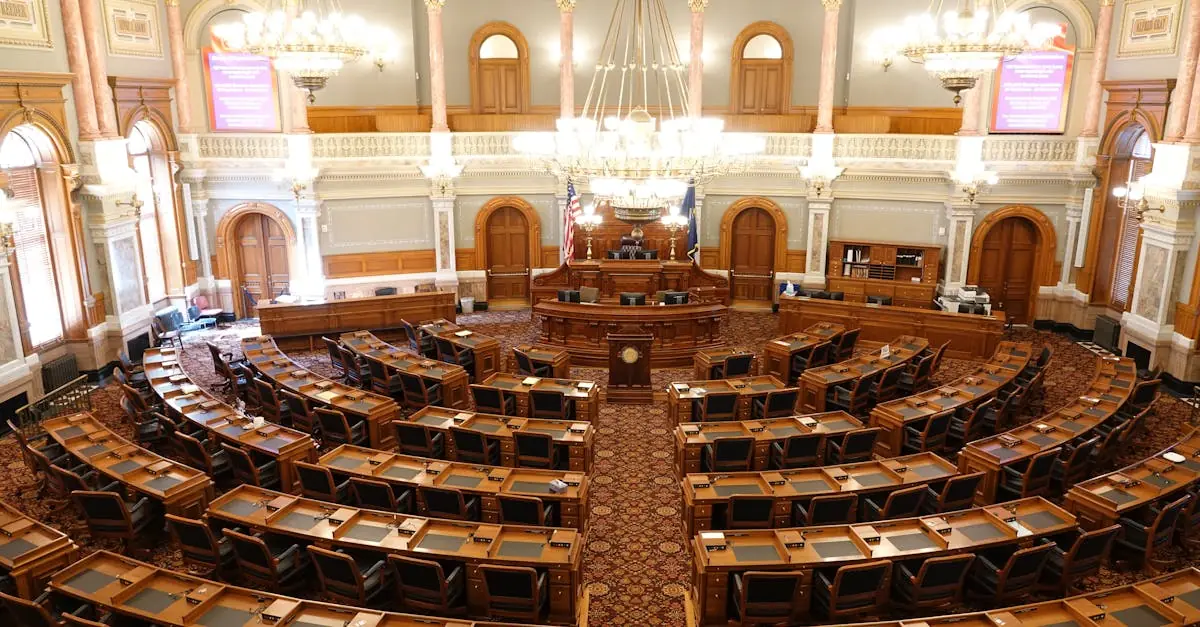In a world where housing often feels like a game of Monopoly gone wrong, mixed-income housing policy emerges as a beacon of hope. Imagine a community where the rich and the not-so-rich can share a cup of coffee without awkwardly eyeing each other’s bank accounts. This innovative approach aims to blend diverse income levels into cohesive neighborhoods, creating vibrant spaces where everyone can thrive.
Table of Contents
ToggleOverview of Mixed-Income Housing Policy
Mixed-income housing policy promotes the integration of residents from diverse income brackets within a single community. This approach aims to combat economic segregation and enhance social cohesion in neighborhoods. By providing affordable housing options alongside market-rate units, these policies foster mixed communities that benefit from shared resources and amenities.
Cities often implement mixed-income housing initiatives through inclusionary zoning, tax incentives, or other regulatory measures. Such strategies encourage developers to allocate a portion of new housing units for low- and moderate-income families. The result enhances access to quality housing for individuals who may otherwise struggle to find affordable options.
Research indicates that mixed-income housing can lead to improved outcomes for residents. Studies show that families living in these environments experience better health, education, and employment opportunities compared to those in economically homogenous areas. Furthermore, these developments can stimulate local economies by increasing consumer spending within the community.
Challenges exist, including potential resistance from existing residents who may fear change or loss of neighborhood identity. Policymakers must engage in robust community consultation to address these concerns effectively. Transparency and education about the benefits of mixed-income housing often mitigate opposition.
While mixed-income housing is not a one-size-fits-all solution, its potential to create inclusive, thriving communities remains significant. By understanding the intricacies of this approach, stakeholders can work towards implementing effective policies that yield lasting benefits for society as a whole.
Benefits of Mixed-Income Housing
Mixed-income housing offers several compelling advantages that enhance community outcomes. Financial stability emerges as a key benefit, addressing both economic and social needs.
Economic Advantages
Increased local spending occurs when diverse residents share community resources. Essentially, when residents from various income brackets transact within the same neighborhoods, businesses thrive. Studies show that mixed-income developments generate higher property values, promoting neighborhood revitalization. Additionally, mixed housing attracts investments, fostering job creation in construction and services. Communities equipped with diverse housing types see reduced demand for public assistance programs. Overall, this model contributes to economic resilience, ensuring communities adapt more effectively to economic fluctuations.
Social Integration
Enhanced social cohesion becomes apparent through mixed-income housing. Individuals from varying backgrounds interact within the same community, fostering understanding and collaboration. Opportunities for networking arise, benefiting residents’ employment prospects. Children raised in mixed-income environments reportedly perform better academically, benefiting from exposure to diverse perspectives. Moreover, fostering a sense of belonging helps reduce crime rates, leading to safer communities. As social integration increases, communities develop a more inclusive culture where everyone contributes positively.
Challenges in Implementation
Mixed-income housing policies face several challenges during implementation. Navigating regulatory frameworks often proves complicated and time-consuming, impacting project feasibility.
Regulatory Hurdles
Regulatory hurdles impede mixed-income housing. Complex zoning laws create confusion for developers and local governments. Developers frequently encounter restrictions that complicate the integration of affordable units within market-rate projects. Obtaining necessary permits can take months, delaying timelines and increasing costs. Local governments may lack clear guidelines, requiring developers to adapt to evolving legislation. Compliance with federal and state regulations further complicates the process. Uncertainty about financial incentives can deter investment, resulting in missed opportunities for community development.
Community Resistance
Community resistance poses another significant challenge. Existing residents often express concerns about potential changes in neighborhood dynamics. Many fear that mixed-income developments might reduce property values or alter the character of their communities. Misunderstandings can lead to mistrust, with some believing that low-income residents will bring crime or instability. Engaging in transparent dialogue among stakeholders can help address these fears. Demonstrating successful examples of mixed-income communities helps alleviate concerns. Building support for mixed-income initiatives requires consistent outreach and education to foster a sense of ownership and acceptance among current residents.
Successful Case Studies
Mixed-income housing policies show promise through various national and international examples that illustrate their positive impacts.
National Examples
San Francisco, California, provides a prime example with its inclusionary housing program. This initiative requires developers to include affordable units in new projects, promoting diversity in high-cost areas. The initiative has increased affordable housing availability while fostering vibrant communities. New York City also demonstrates success through its mandatory inclusionary housing program, which aims to create and preserve affordable housing across all five boroughs. This approach helps residents from different income levels share resources, leading to stronger neighborhood ties.
International Examples
In Canada, Vancouver’s redevelopment of the Olympic Village illustrates mixed-income housing success. The village includes market-rate units alongside affordable ones, promoting accessibility and opportunity for all residents. Similarly, London’s East Village combines affordable housing with market rate homes, encouraging social integration and community interaction. This development fosters cohesion, as residents engage in shared public spaces and amenities. Both cities showcase how mixed-income housing enhances urban life, creating inclusive communities that benefit everyone.
Future of Mixed-Income Housing Policy
Innovative approaches to mixed-income housing policy promise to reshape urban landscapes. Policymakers increasingly recognize the necessity of inclusivity in housing. Current trends indicate a growing emphasis on sustainability and resilience in community planning. Developers play a crucial role in adapting to these evolving policy landscapes by creating housing solutions that meet diverse needs.
Engagement with communities remains essential in the implementation of these policies. Public participation ensures that mixed-income projects reflect the desires of residents. Consequently, local insights improve project acceptance and enhance social integration. Organizations focused on housing equity advocate for transparency, fostering trust among residents and stakeholders.
Data-driven strategies will guide future developments in mixed-income housing. Research continues to highlight the benefits of integrated communities, such as improved educational outcomes and reduced crime rates. Economically diverse neighborhoods foster a sense of belonging, driving connections among residents. Specific metrics, like higher property values, illustrate the economic advantages tied to mixed-income policies.
Technology also plays a significant role in shaping the future. Digital tools can facilitate community engagement and streamline project management. Adaptive reuse of existing structures presents an opportunity to maintain cultural heritage while providing affordable housing options. Policymakers and developers must remain adaptable in response to shifting economic and social trends.
Ultimately, mixed-income housing policies hold the potential to combat inequality effectively. Success hinges on collaboration across sectors, including government, private developers, and community organizations. Continuous analysis and refinement of these policies will enhance their effectiveness in creating equitable living environments.
Mixed-income housing policy stands as a vital strategy for addressing housing inequality and fostering inclusive communities. By blending various income levels within neighborhoods, it cultivates social cohesion and economic resilience. The benefits extend beyond individual households to enhance local economies and create safer environments.
Despite the challenges of implementation and community resistance, successful examples demonstrate the transformative potential of these initiatives. As cities continue to innovate and refine their approaches, the focus on sustainability and community engagement will be crucial. The future of urban living may very well depend on the successful integration of diverse populations, ultimately leading to healthier and more vibrant communities.







